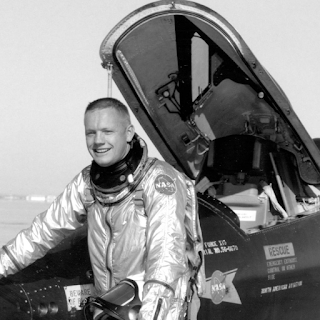Neil Armstrong was famous among military aviators for his bold test flights.
Neil Armstrong was famous among military aviators for
his bold test flights.
On July 20, 1969, he became the first man to set foot on the moon,
Unlike his fellow Apollo 11 astronauts Buzz Aldrin and Mike Collins,
Armstrong was not a military officer assigned to NASA.
He was a civilian, but as a naval aviator during the Korean War, he flew
F9F Panther fighter-bombers from an aircraft carrier off the coast of
North Korea. In the course of five combat tours he earned a reputation
as one of the best pilots in the Navy.
F9F Panther fighter-bombers from an aircraft carrier off the coast of
North Korea. In the course of five combat tours he earned a reputation
as one of the best pilots in the Navy.
He quit the Navy after graduating from Purdue, becoming a full-time civilian
researcher and test pilot, first at the Lewis National Advisory Committee for
Aeronautics (NACA) center outside Cleveland, Ohio
(now called NASA Glenn), and later out of the legendary
Edwards Air Force Base in the California high desert.
Watch Neil Armstrong's historical X-15 flight test here.
Armstrong became famous for flying the dangerous and temperamental researcher and test pilot, first at the Lewis National Advisory Committee for
Aeronautics (NACA) center outside Cleveland, Ohio
(now called NASA Glenn), and later out of the legendary
Edwards Air Force Base in the California high desert.
Watch Neil Armstrong's historical X-15 flight test here.
X-15 rocket plane. His March 1962 X-15 flight took him up to 207,000 feet
in altitude.
in altitude.
His skill as a research and test pilot certainly impressed Buzz Aldrin.
Armstrong was “the best pilot I ever knew,” Aldrin said in an interview
with The Daily Beast shortly after his former colleague’s death.
with The Daily Beast shortly after his former colleague’s death.
Armstrong's ability to memorize the smallest engineering detail and to
be able to explain, in even more detail, the intricate working of any aircraft
he tested made him the outstanding test pilot of his generation.
To this day, within military aviation, he is famous for his "steel trap"
mind and his unflappable demeanor.
be able to explain, in even more detail, the intricate working of any aircraft
he tested made him the outstanding test pilot of his generation.
To this day, within military aviation, he is famous for his "steel trap"
mind and his unflappable demeanor.
He joined the NASA astronaut corps in September 1962.
Armstrong was not only able to take full advantage of this training,
but helped establish the tradition that NASA astronauts will always be
superbly well prepared for their missions.
but helped establish the tradition that NASA astronauts will always be
superbly well prepared for their missions.
His first spaceflight was the Gemini VIII mission flown in March 1966
with his partner David Scott.
with his partner David Scott.
While the NASA program recovered from the January 1967 Apollo 1
disaster that killed Gus Grissom, Roger Chaffee, and Ed White, Armstrong
was hard at work helping develop the Lunar Landing Training Vehicle,
it was used to train Apollo mission commanders in the piloting skills they
would need to land on the lunar surface.
disaster that killed Gus Grissom, Roger Chaffee, and Ed White, Armstrong
was hard at work helping develop the Lunar Landing Training Vehicle,
it was used to train Apollo mission commanders in the piloting skills they
would need to land on the lunar surface.
Armstrong was flying one on May 6, 1968 when it crashed. Armstrong
ejected and parachuted to safety. According to one source, he walked
away without a drop of sweat on him; behind his eyes the pilots and
technicians could almost see him calculating and figuring exactly what
had caused the explosion.
ejected and parachuted to safety. According to one source, he walked
away without a drop of sweat on him; behind his eyes the pilots and
technicians could almost see him calculating and figuring exactly what
had caused the explosion.
The choice of the Apollo 11 crew was partly predetermined by the fact that
Aldrin and Armstrong had trained together as backup for a previous mission.
Once Armstrong had been picked to be the commander, he quickly
decided that he wanted Aldrin in the lunar module with him and that
Mike Collins would be the best man for the job of commanding the
Apollo capsule itself.
Aldrin and Armstrong had trained together as backup for a previous mission.
Once Armstrong had been picked to be the commander, he quickly
decided that he wanted Aldrin in the lunar module with him and that
Mike Collins would be the best man for the job of commanding the
Apollo capsule itself.
Together, on July 16, 1969, they rode the giant Saturn V into orbit.
Arriving in orbit around the moon, Armstrong and Aldrin in the Lunar
Excursion Module (LEM) detached from Collins in the Apollo capsule
and began the nerve-wracking descent towards the moon's surface.
Excursion Module (LEM) detached from Collins in the Apollo capsule
and began the nerve-wracking descent towards the moon's surface.
At 500 feet the commander [Armstrong] took over manual control to
get a feel for what the spacecraft was like before going for the landing.
get a feel for what the spacecraft was like before going for the landing.
Armstrong successfully landed on the moon on July 20, 1969.
As he stepped onto the moon Armstrong intended to say, "It's a small
step for a man, a giant leap for mankind." Instead he pronounced the
now immortal, but grammatically infelicitous words, "It's a small step for
man, a giant leap for mankind."
step for a man, a giant leap for mankind." Instead he pronounced the
now immortal, but grammatically infelicitous words, "It's a small step for
man, a giant leap for mankind."











Comments